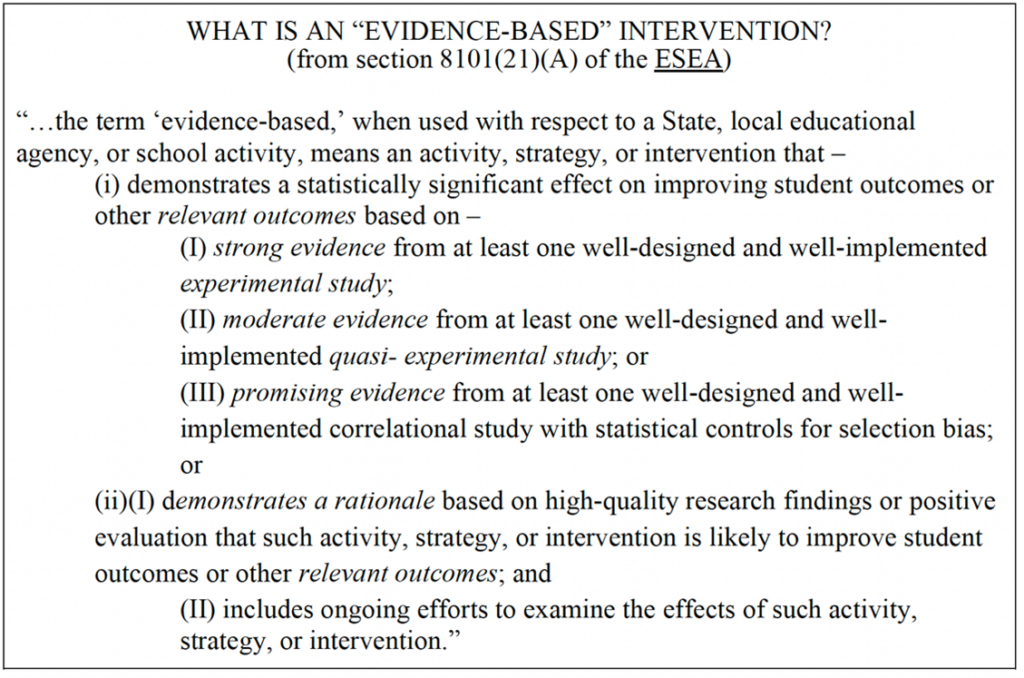Domains
- Preparing for Learning
- Contextualizing the Content
- Engaging in Learning
- Reflecting on Learning
- Transferring Learning to Practice
The purpose of this domain is to assist participants in considering the content in connection with the bigger picture—their standards, goals, or priorities. Presenters should provide participants with evidence that supports the practice, model the practice, and assist participants in determining how the practice will improve outcomes for their students. Darling-Hammond et al. (2017) reviewed 35 studies that were positively connected to student outcomes. All 35 included modeling effective instruction during professional development.
The presenter should:
- Provide evidence for the practice. This includes summarizing and providing citations to research results.
- Provide examples of where and when the practice has been implemented with the associated outcomes.
- Utilize multiple modalities to model implementation (e.g., videos, vignettes, demonstrations).
To support participants in contextualizing the content, the local provider should coordinate with the presenter to:
- Connect the content to local priorities, goals, state standards, and initiatives.
- Provide local example models of implementation, when possible.
- Provide local associated student data, when possible.
Indicator 5. Illustrates alignment between the content and participants’ organizational standards, goals, or priorities.
Participants need to see the connection between the content being presented and their school or organizations’ expectations and mission. Garet et al. (2001) suggested that teachers who experienced professional development connected to other reform efforts and aligned with standards or a mission were more likely to change their practices compared to teachers whose professional development was not coherent. If the innovation will result in a change in their behavior or teaching pedagogy, then a rationale needs to be presented that aligns with their understanding of their role and responsibilities (Knowles, 1988; Malik, 2016).
Indicator 6. Summarizes the evidence base for the content, including providing references or links.
This indicator suggests that the presenter provides evidence that the content or procedures being proposed will result in improved outcomes for students. This may be in the form of research articles or through the use of local data demonstrating impact. The U.S. Department of Education provides nonregulatory guidance on selecting, using, and building evidence-based activities, strategies, and interventions. We encourage providers to consider evidence-based intervention criteria as guidelines for content and practices presented through professional development.

The presenter is asked not only to describe the evidence but also to provide ways for the participant to access this evidence. Usually this includes a reference list, but it could also include hyperlinks to articles or other resources that present the evidence. Comments such as “Research shows …” or “The foundation for this work is …” provide the participants with the suggestion that the content is evidence based but alone are not sufficient to meet this indicator—participants need access to the evidence that convinces them to engage in the practice being proposed. This necessitates that the presenter substantiates the claim that the suggested practices will improve student outcomes.
Indicator 7. Emphasizes the impact of the practice/content on improved outcomes (e.g., student achievement, client well-being).
This indicator suggests that adult learners need to be able to connect the professional development to improve outcomes for students (Knowles, 1988; Malik, 2016). The presenter, therefore, should connect the content to improved student outcomes in order to increase the likelihood of implementation.
Indicator 8. Provides model examples of the content in practice, connected to participants’ context.
The purpose of this indicator is to support implementation not only by providing the participants with examples of the methods being proposed but also by showing that the methods can be implemented in settings that are similar to their own. Providing a representation (e.g., picture, video, graphic, sample student work) of the practice in action helps the participants envision implementation in their own environments with their students. Providing participants with examples or models of a practice during professional development has been shown to positively impact overall implementation (Darling-Hammond et al., 2017; Sims et al., 2023).
